Stavros Petridis
Contextual Speech Extraction: Leveraging Textual History as an Implicit Cue for Target Speech Extraction
Mar 11, 2025Abstract:In this paper, we investigate a novel approach for Target Speech Extraction (TSE), which relies solely on textual context to extract the target speech. We refer to this task as Contextual Speech Extraction (CSE). Unlike traditional TSE methods that rely on pre-recorded enrollment utterances, video of the target speaker's face, spatial information, or other explicit cues to identify the target stream, our proposed method requires only a few turns of previous dialogue (or monologue) history. This approach is naturally feasible in mobile messaging environments where voice recordings are typically preceded by textual dialogue that can be leveraged implicitly. We present three CSE models and analyze their performances on three datasets. Through our experiments, we demonstrate that even when the model relies purely on dialogue history, it can achieve over 90 % accuracy in identifying the correct target stream with only two previous dialogue turns. Furthermore, we show that by leveraging both textual context and enrollment utterances as cues during training, we further enhance our model's flexibility and effectiveness, allowing us to use either cue during inference, or combine both for improved performance. Samples and code available on https://miraodasilva.github.io/cse-project-page .
Adaptive Audio-Visual Speech Recognition via Matryoshka-Based Multimodal LLMs
Mar 09, 2025Abstract:Audio-Visual Speech Recognition (AVSR) leverages both audio and visual modalities to enhance speech recognition robustness, particularly in noisy environments. Recent advancements in Large Language Models (LLMs) have demonstrated their effectiveness in speech recognition, including AVSR. However, due to the significant length of speech representations, direct integration with LLMs imposes substantial computational costs. Prior approaches address this by compressing speech representations before feeding them into LLMs. However, higher compression ratios often lead to performance degradation, necessitating a trade-off between computational efficiency and recognition accuracy. To address this challenge, we propose Llama-MTSK, the first Matryoshka-based Multimodal LLM for AVSR, which enables flexible adaptation of the audio-visual token allocation based on specific computational constraints while preserving high performance. Our approach, inspired by Matryoshka Representation Learning, encodes audio-visual representations at multiple granularities within a single model, eliminating the need to train separate models for different compression levels. Moreover, to efficiently fine-tune the LLM, we introduce three LoRA-based Matryoshka strategies using global and scale-specific LoRA modules. Extensive evaluations on the two largest AVSR datasets demonstrate that Llama-MTSK achieves state-of-the-art results, matching or surpassing models trained independently at fixed compression levels.
Zero-AVSR: Zero-Shot Audio-Visual Speech Recognition with LLMs by Learning Language-Agnostic Speech Representations
Mar 08, 2025Abstract:We explore a novel zero-shot Audio-Visual Speech Recognition (AVSR) framework, dubbed Zero-AVSR, which enables speech recognition in target languages without requiring any audio-visual speech data in those languages. Specifically, we introduce the Audio-Visual Speech Romanizer (AV-Romanizer), which learns language-agnostic speech representations by predicting Roman text. Then, by leveraging the strong multilingual modeling capabilities of Large Language Models (LLMs), we propose converting the predicted Roman text into language-specific graphemes, forming the proposed Cascaded Zero-AVSR. Taking it a step further, we explore a unified Zero-AVSR approach by directly integrating the audio-visual speech representations encoded by the AV-Romanizer into the LLM. This is achieved through finetuning the adapter and the LLM using our proposed multi-task learning scheme. To capture the wide spectrum of phonetic and linguistic diversity, we also introduce a Multilingual Audio-Visual Romanized Corpus (MARC) consisting of 2,916 hours of audio-visual speech data across 82 languages, along with transcriptions in both language-specific graphemes and Roman text. Extensive analysis and experiments confirm that the proposed Zero-AVSR framework has the potential to expand language support beyond the languages seen during the training of the AV-Romanizer.
KeyFace: Expressive Audio-Driven Facial Animation for Long Sequences via KeyFrame Interpolation
Mar 03, 2025Abstract:Current audio-driven facial animation methods achieve impressive results for short videos but suffer from error accumulation and identity drift when extended to longer durations. Existing methods attempt to mitigate this through external spatial control, increasing long-term consistency but compromising the naturalness of motion. We propose KeyFace, a novel two-stage diffusion-based framework, to address these issues. In the first stage, keyframes are generated at a low frame rate, conditioned on audio input and an identity frame, to capture essential facial expressions and movements over extended periods of time. In the second stage, an interpolation model fills in the gaps between keyframes, ensuring smooth transitions and temporal coherence. To further enhance realism, we incorporate continuous emotion representations and handle a wide range of non-speech vocalizations (NSVs), such as laughter and sighs. We also introduce two new evaluation metrics for assessing lip synchronization and NSV generation. Experimental results show that KeyFace outperforms state-of-the-art methods in generating natural, coherent facial animations over extended durations, successfully encompassing NSVs and continuous emotions.
Unified Speech Recognition: A Single Model for Auditory, Visual, and Audiovisual Inputs
Nov 04, 2024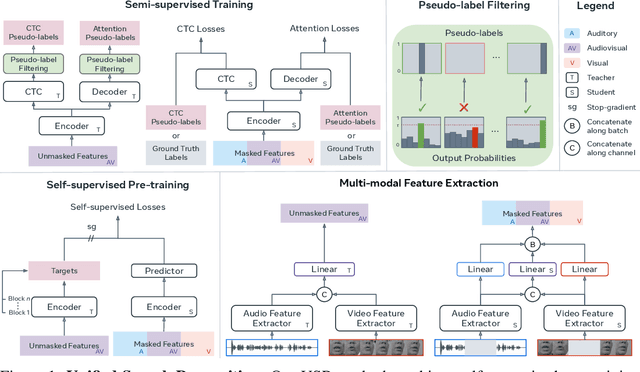



Abstract:Research in auditory, visual, and audiovisual speech recognition (ASR, VSR, and AVSR, respectively) has traditionally been conducted independently. Even recent self-supervised studies addressing two or all three tasks simultaneously tend to yield separate models, leading to disjoint inference pipelines with increased memory requirements and redundancies. This paper proposes unified training strategies for these systems. We demonstrate that training a single model for all three tasks enhances VSR and AVSR performance, overcoming typical optimisation challenges when training from scratch. Moreover, we introduce a greedy pseudo-labelling approach to more effectively leverage unlabelled samples, addressing shortcomings in related self-supervised methods. Finally, we develop a self-supervised pre-training method within our framework, proving its effectiveness alongside our semi-supervised approach. Despite using a single model for all tasks, our unified approach achieves state-of-the-art performance compared to recent methods on LRS3 and LRS2 for ASR, VSR, and AVSR, as well as on the newly released WildVSR dataset. Code and models are available at https://github.com/ahaliassos/usr.
Full-Rank No More: Low-Rank Weight Training for Modern Speech Recognition Models
Oct 10, 2024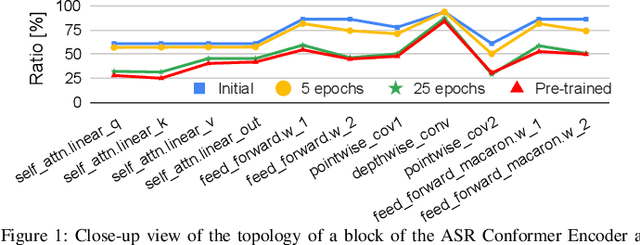
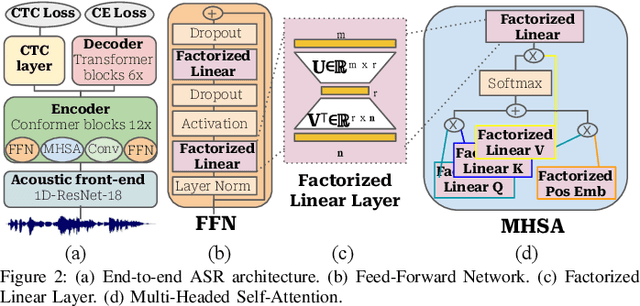
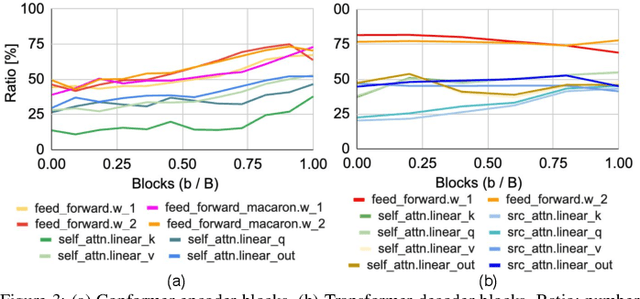
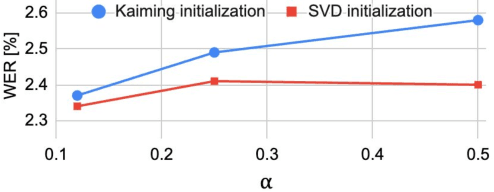
Abstract:This paper investigates the under-explored area of low-rank weight training for large-scale Conformer-based speech recognition models from scratch. Our study demonstrates the viability of this training paradigm for such models, yielding several notable findings. Firstly, we discover that applying a low-rank structure exclusively to the attention modules can unexpectedly enhance performance, even with a significant rank reduction of 12%. In contrast, feed-forward layers present greater challenges, as they begin to exhibit performance degradation with a moderate 50% rank reduction. Furthermore, we find that both initialization and layer-wise rank assignment play critical roles in successful low-rank training. Specifically, employing SVD initialization and linear layer-wise rank mapping significantly boosts the efficacy of low-rank weight training. Building on these insights, we introduce the Low-Rank Speech Model from Scratch (LR-SMS), an approach that achieves performance parity with full-rank training while delivering substantial reductions in parameters count (by at least 2x), and training time speedups (by 1.3x for ASR and 1.15x for AVSR).
RT-LA-VocE: Real-Time Low-SNR Audio-Visual Speech Enhancement
Jul 10, 2024Abstract:In this paper, we aim to generate clean speech frame by frame from a live video stream and a noisy audio stream without relying on future inputs. To this end, we propose RT-LA-VocE, which completely re-designs every component of LA-VocE, a state-of-the-art non-causal audio-visual speech enhancement model, to perform causal real-time inference with a 40ms input frame. We do so by devising new visual and audio encoders that rely solely on past frames, replacing the Transformer encoder with the Emformer, and designing a new causal neural vocoder C-HiFi-GAN. On the popular AVSpeech dataset, we show that our algorithm achieves state-of-the-art results in all real-time scenarios. More importantly, each component is carefully tuned to minimize the algorithm latency to the theoretical minimum (40ms) while maintaining a low end-to-end processing latency of 28.15ms per frame, enabling real-time frame-by-frame enhancement with minimal delay.
Dynamic Data Pruning for Automatic Speech Recognition
Jun 26, 2024Abstract:The recent success of Automatic Speech Recognition (ASR) is largely attributed to the ever-growing amount of training data. However, this trend has made model training prohibitively costly and imposed computational demands. While data pruning has been proposed to mitigate this issue by identifying a small subset of relevant data, its application in ASR has been barely explored, and existing works often entail significant overhead to achieve meaningful results. To fill this gap, this paper presents the first investigation of dynamic data pruning for ASR, finding that we can reach the full-data performance by dynamically selecting 70% of data. Furthermore, we introduce Dynamic Data Pruning for ASR (DDP-ASR), which offers several fine-grained pruning granularities specifically tailored for speech-related datasets, going beyond the conventional pruning of entire time sequences. Our intensive experiments show that DDP-ASR can save up to 1.6x training time with negligible performance loss.
MSRS: Training Multimodal Speech Recognition Models from Scratch with Sparse Mask Optimization
Jun 25, 2024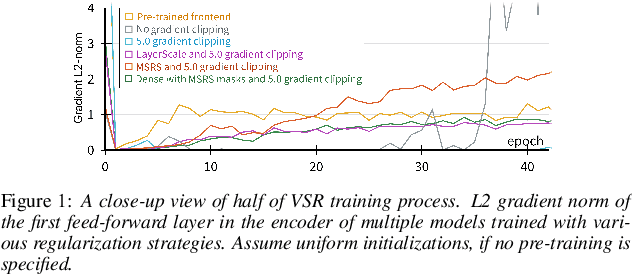
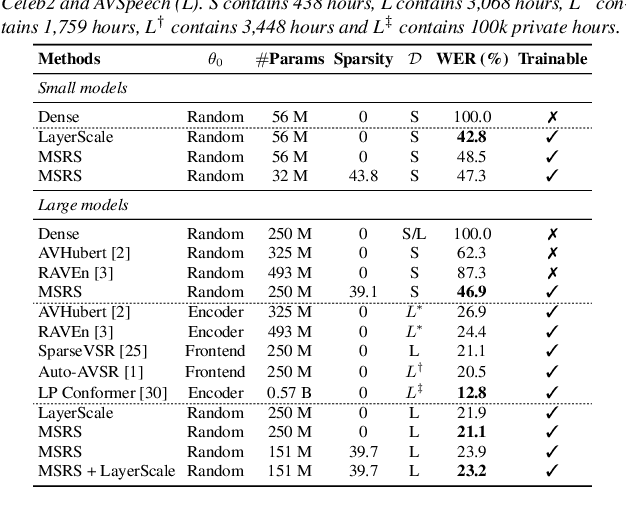
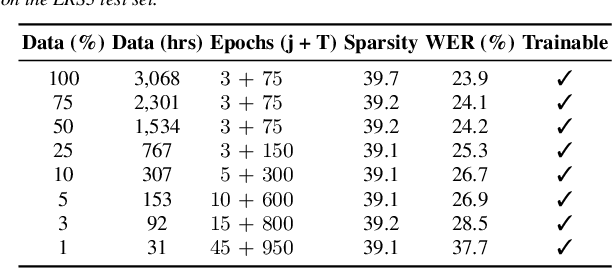
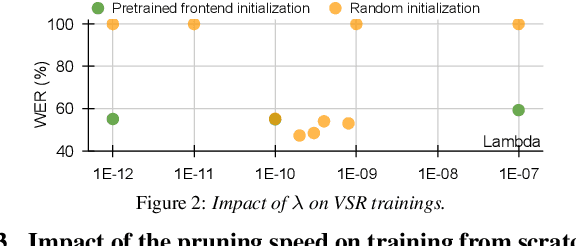
Abstract:Pre-trained models have been a foundational approach in speech recognition, albeit with associated additional costs. In this study, we propose a regularization technique that facilitates the training of visual and audio-visual speech recognition models (VSR and AVSR) from scratch. This approach, abbreviated as \textbf{MSRS} (Multimodal Speech Recognition from Scratch), introduces a sparse regularization that rapidly learns sparse structures within the dense model at the very beginning of training, which receives healthier gradient flow than the dense equivalent. Once the sparse mask stabilizes, our method allows transitioning to a dense model or keeping a sparse model by updating non-zero values. MSRS achieves competitive results in VSR and AVSR with 21.1% and 0.9% WER on the LRS3 benchmark, while reducing training time by at least 2x. We explore other sparse approaches and show that only MSRS enables training from scratch by implicitly masking the weights affected by vanishing gradients.
EMOPortraits: Emotion-enhanced Multimodal One-shot Head Avatars
Apr 29, 2024Abstract:Head avatars animated by visual signals have gained popularity, particularly in cross-driving synthesis where the driver differs from the animated character, a challenging but highly practical approach. The recently presented MegaPortraits model has demonstrated state-of-the-art results in this domain. We conduct a deep examination and evaluation of this model, with a particular focus on its latent space for facial expression descriptors, and uncover several limitations with its ability to express intense face motions. To address these limitations, we propose substantial changes in both training pipeline and model architecture, to introduce our EMOPortraits model, where we: Enhance the model's capability to faithfully support intense, asymmetric face expressions, setting a new state-of-the-art result in the emotion transfer task, surpassing previous methods in both metrics and quality. Incorporate speech-driven mode to our model, achieving top-tier performance in audio-driven facial animation, making it possible to drive source identity through diverse modalities, including visual signal, audio, or a blend of both. We propose a novel multi-view video dataset featuring a wide range of intense and asymmetric facial expressions, filling the gap with absence of such data in existing datasets.
 Add to Chrome
Add to Chrome Add to Firefox
Add to Firefox Add to Edge
Add to Edge